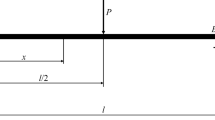Summary
The deformability of a composite solid can be estimated as a properly selected average of the deformabilities of the phases. The arithmetic and harmonic averages of the phase deformations provide the two best known and simplest laminated models. Analogues of these laminated models are shown as connected springs or as connected ohmic resistances. The needed “g” blending proportions can also be calculated when the required modulus of elasticity of the composite as well as the moduli of the phases are given. The mathematics of three-phase composite models is more complicated. This can be simplified by the use of triangular diagrams. The combination of a computer of graphical terminals with the triangular diagram method is shown as particularly advantageous.
Résumé
La déformabilité d'un solide composite peut être considérée comme une moyenne judicieusement choisie des déformations de ses composants. Les moyennes arithmétique et harmonique des déformations des composants fournissent les deux meilleurs et les deux plus simples modèles stratifés connus (fig. 1 et 1b). On montre que les moyennes de ces deux modèles (fig. 1c et 1d) permettent une plus juste approximation entre les valeurs calculées et expérimentales. Les analogies mécaniques de ces modèles stratifiés sont représentées par des ressorts connectés (fig. 2), et les analogies électriques par des résistances ohmiques connectées (fig. 3). Le modèle composite traduit par la moyenne géométrique des déformations des composants ne possède pas une simple analogie mécanique ou électrique. Les proportions des composants (g) peuvent être aussi déterminées si l'on connaît tant le module d'élasticité du matériau composite que celui de chacun des composants. Pour deux composants, on se référera aux équations de (6) à (10). Pour trois composants, le calcul se complique, mais peut être simplifié par l'emploi de diagrammes triangulaires. Une fois établi, un système linéaire des valeurs E constantes (voir fig. 5 pour Ea et les figures qui suivent pour les autres modules moyens), le module d'élasticité composite pour quelles constructions que ce soient des 3 phases peut être lu directement sur le diagramme ou, inversement, la totalité des combinaisons possibles de composants pour une valeur donnée de E composite, même avec des limites de tolérance et des conditions subsidiaires. La combinaison d'un calculateur couplé à un traceur de courbe avec la méthode du diagramme triangulaire se révèle comme particulièrement avantageuse.
Similar content being viewed by others
References
Hansen, T. C.—“Strength, elasticity, and creep as related to the internal structure of concrete”, Chemistry of Cement. Proceedings of the Fourth International Symposium. Monograph 43. Vol. II, Washington, 1960, pp. 709–723.
Hansen, T. C.—“Thermal and electrical conductivity and modulus of elasticity of two-phase composite materials. Influence of Poisson's ratio and phase distribution”. RILEM Bulletin, No. 31, Paris, June, 1966, pp. 253–256.
Popovics, S.— “The model approach to two-phase composite materials”, Bulletin, American Ceramic Society, Vol. 48, No. 2, Nov. 1969, pp. 1060–1064.
Popovics, S.— “Effect of porosity on the strength of concrete”, Journal of Materials, JMLSA, Vol. 4, No. 2, June, 1969, pp. 356–371.
Paul, B.— “Prediction of elastic constants of multiphase materials”, Transactions of the Metallurgical Society of AIME, Vol. 218, February, 1960, pp. 36–41.
Bates, A. A.— “Composites in construction”, Stanton Walker Lecture Series on the Materials Sciences, Lecture No. 1. Presented at the University of Maryland, November, 1963.
Hirsch, T. J.— “Modulus of elasticity of concrete affected by elastic modulus of cement paste, matrix and aggregate”, ACI Journal, Proceedings, Vol. 59, March, 1962, pp. 427–451.
Dougill, J. W.— Discussion of reference [7]. “, ACI Journal, Proceedings, Vol. 59, September, 1962, pp. 1363–1365.
Popovics, S.— “Theory and application of triangular diagrams”, RILEM Bulletin, No. 22, Paris, March, 1964, pp. 37–43.
Popovics, S.— “A betonadalék szemszerkezetjavitására vonatkozo számitások háromszogkoordinátarendszerben” (Calculations of Blending Proportions for Mineral Aggregates in Triangular Diagrams), ÉTI Tudományos Kozlemények, No. 9, Budapest, 1956.
Voigt, W.— Lehrbuch der Kristallphysik (Textbook for Crystall Physics), Teubner, Leipzig und Berlin, 1928, pp. 716–761.
Reuss, A.— “Berechnung der Fliessgrenze von Mischkristallen auf Grund der Plastizitatsbedingung für Einkristalle” (Calculation of the Yield Limit for Polycrystals from the Plasticity Condition for Single Crystals) Zeitschrift für angewendte Mathematik and Mechanik, Vol. 9, No. 1, February, 1929, pp. 49–58.
Lichtenecker, K.— Physik. Z., Vol. 27, 1926, pp. 115–158.
Author information
Authors and Affiliations
Rights and permissions
About this article
Cite this article
Popovics, S., Erdey, M.R.A. Estimation of the modulus of elasticity of concrete-like composite materials. Mat. Constr. 3, 253–260 (1970). https://doi.org/10.1007/BF02474013
Issue Date:
DOI: https://doi.org/10.1007/BF02474013




